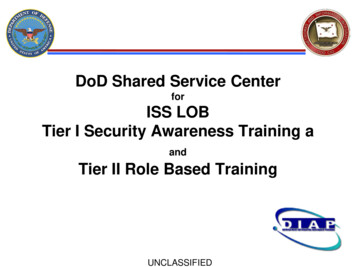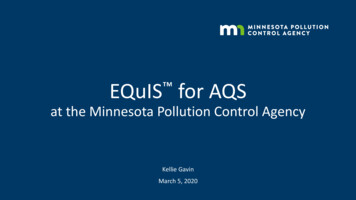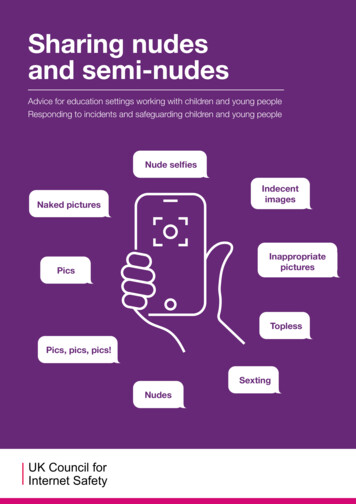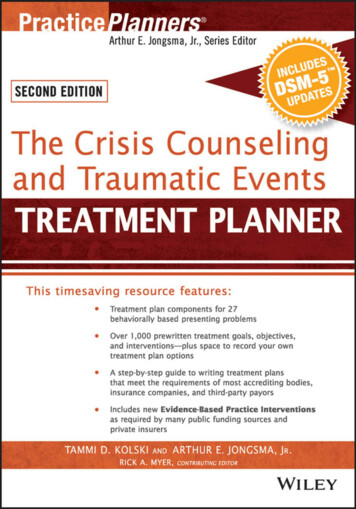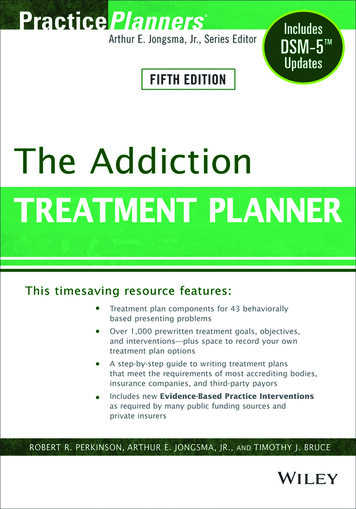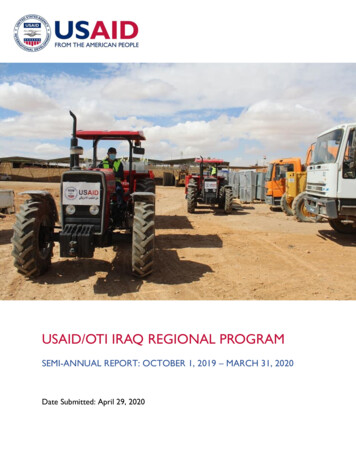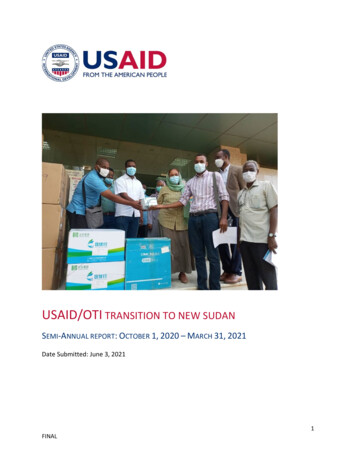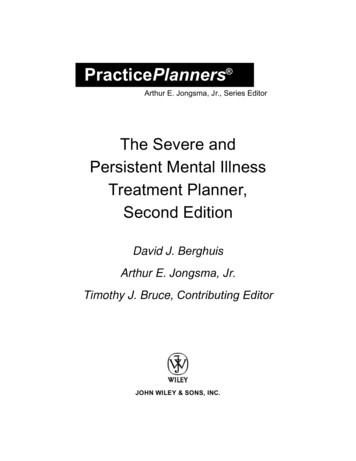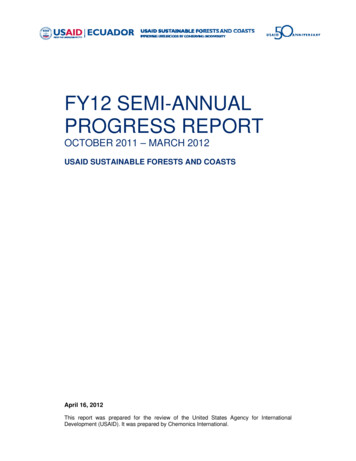
Transcription
FYY122 SEEMI-ANNNUAALPROGGREESSS REEPOORTOCCTOBERR 2011 – MARCCH 2012AID SUSTTAINABLEE FORESSTS AND COASTSSUSAApril 16, 2012ed States Agency for InnternationalThis report was prepared forr the review of the UniteDevellopment (USAAID). It was prepared by CChemonics Intternational.
FY12 SEMI-ANNUALPROGRESS REPORTOCTOBER 2011 – MARCH 2012USAID SUSTAINABLE FORESTS AND COASTSContract No. EPP-I-00-06-00013-00 TO #377The author’s views expressed in this publication do not necessarily reflect the views of theUnited States Agency for International Development or the United States Government.
CONTENTSEXECUTIVE SUMMARY .4SECTION 1: SUMMARY OF RESULTS .6SECTION 2: INTRODUCTION .10SECTION 3: FY12 WORK PLAN PROGRESS BY PIR .12THREAT 1: LOSS OR ALTERATION OF CRITICAL HABITATS .12STRATEGY 1.1: IMPROVE MANAGEMENT OF CRITICALTERRESTRIAL AND COASTAL MARINE HABITATS .12STRATEGY 1.2: REHABILITATE DEGRADED HABITATS .19THREAT 2: CLIMATE CHANGE .20STRATEGY 2.2.: REDUCTION OF GREENHOUSE GASES ANDCARBON SINK CONSERVATION .21THREAT 3: LACK OF ECONOMIC ALTERNATIVES.22STRATEGY 3.1: DEVELOPMENT AND PROMOTION OF MARKETBASED ECONOMIC ALTERNATIVES AND ECONOMIC INCENTIVESFOR CRITICAL HABITAT CONSERVATION .22ACTIVITY 3.1.1 FACILITATE ACCESS TO ENVIRONMENTALLYRESPONSIBLE MARKETS AND SUPPORT FOR MICROENTERPRISE.23ACTIVITY 3.1.2: DEVELOP ECONOMIC INCENTIVES FORCONSERVATION .24ACTIVITY 3.1.3 SUPPORT ACCESSING AND MAINTAINING SOCIOBOSQUE’S INCENTIVES .25ACTIVITY 3.1.4.: STRENGTHEN VALUE CHAINS THAT PROMOTEBIODIVERSITY CONSERVATION .26THREAT 4: INSUFFICIENT INSTITUTIONAL CAPACITY FORBIODIVERSITY CONSERVATION .28STRATEGY 4.1 STRENGTHEN MANAGEMENT OF PROTECTEDAREAS .28THREAT 4: INSUFFICIENT INSTITUTIONAL CAPACITY FORBIODIVERSITY CONSERVATION .29STRATEGY 4.1 STRENGTHEN MANAGEMENT OF PROTECTEDAREAS .29STRATEGY 4.2.: IMPROVE INTER-INSTITUTIONAL COMMUNICATIONAND COORDINATION .34STRATEGY 4.3.: PUBLIC POLICY ADVOCACY .41SECTION 4: ENVIRONMENTAL COMPLIANCE .44SECTION 5: CHALLENGES ENCOUNTERED, SOLLUTIONS IDENTIFIED,AND LESSONS LEARNED .45stUSAID SUSTAINABLE FORESTS AND COASTS PROJECT 1 FY12 SEMI-ANNUAL PROGRESSREPORT1
SECTION 6: ADAPTIVE MANAGEMENT APPROACH.47SECTION 7: BEST PRACTICES TO BE TAKEN TO SCALE .48ANNEX 1: WORK PLAN STATUS CHARTS BY GEOGRAPHIC AREA .501)GRAN RESERVA CHACHI AND ITS BUFFER ZONE.502) RESERVA MARINA GALERA SAN FRANCISCO AND WATERSHEDSOF THE GALERA SAN FRANCISCO PENINSULA .513) PARQUE NACIONAL MACHALILLA AND AYAMPE RIVERWATERSHED .525)CHONGÓN COLONCHE MOUNTAIN RANGE .586)GUAYAS PROVINCE .60ANNEX 2: RESULTS REPORTING TABLES .61A.SUMMARY OF THE PROJECT S USAID/ECUADOR INDICATORS .61B.SUMMARY OF THE PROJECT S INDICATORS BY PIR .62C. SUMMARY OF THE PROJECT S INDICATORS BY PIR (WITHGEOGRAPHIC REFERENCES).65ANNEX 3: PERFORMANCE INDICATOR NARRATIVE.69ANNEX 4: FRA UPDATE FROM SIGA: AGRO-FORESTRYREFORESTATION .79ANNEX 5: FRA UPDATE FROM SIGA: INTEGRATED FARMS .79ANNEX 6: FRA UPDATE FROM SIGA: MANGROVE MANAGEMENT ANDSUSTAINABLE RED CRAB COLLECTION .79ANNEX 7: FRA UPDATE FROM SIGA: FORESTRY HARVESTING .79ANNEX 8: FRA UPDATE FROM SIGA: TAGUA MANAGEMENT .79ANNEX 9: FRA UPDATE FROM SIGA: AFRICAN SNAIL CONTROL .79ANNEX 10: UPDATED PROJECT CALENDAR.79ANNEX 11: BENEFITING FARMERS AND CONSERVATION CASE STUDY.79stUSAID SUSTAINABLE FORESTS AND COASTS PROJECT 1 FY12 SEMI-ANNUAL PROGRESSREPORT2
NPOAMPNMRERMRPFSIGASNAPUSAIDField SchoolsFederación de Centros Cháchis de Ecuador (EcuadorianFederation of Cháchi Communites )Fiscal YearFichas de Revisión Ambiental (Environmental ReviewWorksheet)Instituto Nacional de Meteorología e Hidrología (NationalInstitute of Meteorology and Hydrology)Instituto Nacional de Pesca (National Institute of Fisheries)Ministerio de Ambiente (Ministry of Environment)Ministerio de Agricultura, Ganadería, Aquacultura y Pesca(Ministry of Agricultural, Livestock, Aquaculture and Fisheries)Ministerio de Turismo del Ecuador (Ministry of Tourism ofEcuador)Project Intermediate ResultsParque Nacional (National Park)Plan de Ordenamiento AmbientalParque Nacional Machalilla (Machalilla National Park)Reserva Ecológica (Ecological Reserve)Reserva Marina (Marine Reserve)Reserva de Producción Faunística (Wildlife Production Reserve)Sistema de Información de Gestión Ambiental (EnvironmentalManagement and Information System)Sistema Nacional de Áreas Protegidas (National System ofProtected Areas)United States Agency for International DevelopmentstUSAID SUSTAINABLE FORESTS AND COASTS PROJECT 1 FY12 SEMI-ANNUAL PROGRESSREPORT3
EXECUTIVE SUMMARYThe present Semi-Annual Progress Report provides an update on implementation ofFY12 annual work plan activities and progress made towards FY12 targets establishedin the updated Performance Monitoring Plan (PMP)1. It complements the weekly andmonthly reports that are submitted to the Contracting Officer s Representative (COR).The Project s implementation strategy remains focused on reducing the following fourmain threats to biodiversity conservation in six priority sites along the coast ofEcuador: (1) Loss and/or alteration of critical habitats, (2) Climate change, (3) Lack ofeconomic alternatives, and (4) Insufficient institutional capacity for biodiversityconservation. To this end, the project has built local capacity to manage ProtectedAreas, implement climate change adaptation measures, and manage integrated farms.In addition, the project has provided tools for communities and local governments tomitigate and respond to climate risks and is helping develop a climate change strategyfor the entire Guayas province. It is also promoting market access for products thatsupport conservation (such as red crab, which depend on protecting mangroves; tagua,which depends on forest conservation; and organic cacao produced usingenvironmentally safe practices). To improve livelihoods it also helps people accesscash-for-conservation payments for protecting natural forests under the Ministry ofEnvironment s (MAE) Socio Bosque Program. The project continues to work in closepartnership with the MAE and provide high level policy guidance, which thissemester included helping guide integration of the national biodiversity and climatechange programs into the new Environmental Code proposal.To date, the Project has trained 3,399 people, promoted 14 new commercial linkages,and helped individuals and communities access 7.7M in cash-for conservationpayments for protecting 33,285 hectares2. As a result of project technical assistance,over 10,135 people are benefiting economically and 362,575 hectares are underimproved management. Parallel to this, the Project strengthened conservationcoalitions that serve as platforms for coordinating natural resource management withlocal public and private sector actors, and has leveraged over 13.7 million. For amore detailed summary of results to date please see Section 1.Especially noteworthy achievements this reporting period include (1) expanding theconservation coalition in the Gulf of Guayaquil and concluding one year of datacollection for the red crab stock analysis, (2) implementing climate change adaptationmeasures in El Salado and initiating them for Parque Nacional Machalilla, (3)supporting tagua collectors in adding value to their harvests, (4) developing a Manualon Best Practices for Developing Climate Change Adaptation Measures in CoastalRegions (5) strengthening mangrove concession management, helping new groupsapply for concessions and helping the 6 de Julio Crabber s Association renew itsconcession, (6) incorporating activities from the Ayampe Environmental Land UsePlan into the Territorial Land Use Plan (Plan de Ordenamiento Territorial – POT) for1This semester the PMP is being revised in response to changes requested in TO Mod 4. In addition the project hasproposed increasing several targets and making some other minor revisions in the updated PMP. The targets presented inthis report are in accordance with the PMP submitted on March 29, 2012 for COR approval.2The project supported submitting applications for an additional 1M and 3,058 hectares, which are not counted here as theyare pending MAE approvalstUSAID SUSTAINABLE FORESTS AND COASTS PROJECT 1 FY12 SEMI-ANNUAL PROGRESSREPORT4
the municipality on Jipijapa and presenting the respective municipal ordinance forapproval, (7) facilitating reforestation to protect water sources (8) providing technicalassistance for integrated farm management (10) presenting an assessment regardingsmall producer s perceptions of profitability for timber products in Ecuador (“Sondeosobre la percepción de la rentabilidad del aprovechamiento de madera por parte depequeños productores en Ecuador” to high level MAE authorities (11) continuing tosupport the MAE to improve protected area management, including tourism andfishery management and strengthening surveillance and monitoring systems (12)initiated participatory process for developing a Protected Area Management Manualthat will be used across Ecuador, and (13) supporting new applications to protect over7,000 hectares under Socio Bosque and helping communities already in Socio Bosqueincrease their payments by over 2.6M per the updated rates approved in 2011. Thisperiod the project has also expanded communications materials, launching the firstproject video regarding its work to strengthen livelihoods and protect mangroves inthe Gulf of Guayaquil, and initiating monthly newsletters in English. The projectrecognizes the role that the guidance and continual support the COR, Rocío Cedeño,has played in meeting its goals and implementing work plan activities to date.stUSAID SUSTAINABLE FORESTS AND COASTS PROJECT 1 FY12 SEMI-ANNUAL PROGRESSREPORT5
SECTION 1: SUMMARY OF RESULTSThe Project continued reducing threats to biodiversity conservation in six priority sitesalong the coast of Ecuador. The following is a summary of results to date throughMarch 31, 2012: 33,285 hectares (ha) 3 of natural forest being protected under the Socio BosqueProgram for which 7.7M in cash-for-conservation payments have beencommitted, benefiting 8,040 people:– Ayampe River Watershed: 7,604 ha– Coastal Watersheds by Galera San Francisco Marine Reserve, 395 ha– Gran Reserva Chachi, 25,286 ha As part of technical assistance to meet Socio Bosque requirements for applyingfor conservation incentives, to date the Project has provided legal and technicalassistance with land titling for 6,864 ha (406 ha in Esmeraldas and 6,458 ha inAyampe), which will benefit 495 people and result in increasing property valuesby approximately 170% -- 1,441,524 in total value. 295,816 ha Under Surveillance and Enforcement Systems:– Churute Mangrove Ecological Reserve/Concessions, 65,110ha– Centros Chachi Sabalito, Capuli, Guadual and Calle Manza, 8,108 ha– Ayampe River Watershed/ Machalilla National Park: 167,977 ha– Galera San Francisco Marine Reserve, 54,621 ha 25,545 ha under new Mangrove Concessions (representing 80% of concessionareas in the Gulf of Guayaquil) and successfully renewed a concession with 1,284ha. 2,889 ha of forest under protection/regeneration– Ayampe River Watershed, 1,556 ha– Esmeraldas, 1333 ha 10,135 people with increased economic benefits:1) 8640 people as a result of the Project s assistance in obtaining SocioBosque economic incentives as well as resources obtained from the PMRCfor surveillance of mangrove concessions.2) 120 people as a result of new commercial relationships facilitated for redcrab pulp processors in the Gulf of Guayaquil.3) 1,170 people as a result of improved management practices (ECAs).4) 30 people benefiting from improved tourism resources (recycling centersin Las Tunas)5) 175 people as a result of improved practices for non timber products (taguasales).3This represents the hectares from the applications that have already been approved by Socio Bosque. Applications for anadditional 1M and 3,058 hectares have been submitted and are pending MAE approval.stUSAID SUSTAINABLE FORESTS AND COASTS PROJECT 1 FY12 SEMI-ANNUAL PROGRESSREPORT6
3,399 People trained (2,708 men and 691 women) in Natural ResourceManagement and Initiating Improved Practices:1) 301 in La Gran Reserva Chachi,2) 700 in Galera San Francisco,3) 980 in Ayampe4) 1,418 Gulf of Guayaquil 14 new commercial linkages1) Las Delicias (linked with Tagua buyer, Alen Bosligua)2) Ecocacao Producer s Association (linked with Hotel Club del Sol for sales oftropical fruit)3) Ecocacao Producer s Association (linked with Hotel Tiburon)4) Ecocacao Producer s Association (linked with Hotel Hotel Siona)5) Ecocacao Producer s Association (linked with Hotel Cielo Azul)6) Ecocacao Producer s Association (linked with Hotel Aldea Mar)7) Crab Women Association 6 de Julio (linked with Marrecife)8) Crab Women Association 6 de Julio (linked with Unipark)9) Crab Women Association 6 de Julio (linked with Rey de las Ostras)10) Producers from the Upper Ayampe River Watershed ECAs (linked with themunicipal market in Jipijapa to sell produce)11) Producers from Vueltas Largas - Venta de hortalizas a hoteles de la zona12) Crab Association Bella Vista - venta directa de cangrejo en la Caraguay13) Producers from El Corocito - acuerdos de comercialización en el mercado deJipíjapa14) Ecocacao Producer s Association (exporting organic cacao to Nova Munda) 156 model integrated farms implementing integral farm management plans for4,060 ha.– 96 Ecocacao Producer s Association (3,204 ha)– 60 in Ayampe (856 ha) 5 Conservation Coalitions formed and operating: 1) Stakeholders in Gran ReservaChachi, 2) Stakeholders in Galera San Francisco, 3) Crabbing Associations inMondragón, 4) Stakeholders in Ayampe, 5) INP and crab associations in Gulf ofGuayaquil. A Security Committee Operating in Puerto López (Comité De SeguridadCiudadana) and receiving institutional strengthening support as well as technicalassistance. Continued Strong Coordination with:1) Municipalities: Puerto Lopez, Jipijapa, and Paján;2) Provincial Governments: Manabí, Esmeraldas, and Guayas;3) Juntas Parroquiales: Quingue, Galera, San Francisco Del Cabo, PedroPablo Gómez;4) Ministries: MAE, Ministry of Tourism (MINTUR), and Ministerio deAgricultura, Ganadería, Acuacultura, y Pesca (MAGAP); and5) National Fishery Institute (INP)6) National Bureau of Aquatic Spaces (DIRNEA)stUSAID SUSTAINABLE FORESTS AND COASTS PROJECT 1 FY12 SEMI-ANNUAL PROGRESSREPORT7
7) Ecuadorian Navy s Oceanography Institute (INOCAR) 13,734,131 in Funds Leveraged for Biodiversity Conservation:Alianza Sur - MondragónAsociación BalaoAsociación Costa RicaAsociación Seis de JulioBIDCI InternacionalCorporación Andina de FomentoFundación McArthurGobiernos locales de Manabi y Puerto LópezGroenhartMAE Socio BosqueMAEMINTURPROFORESTALEcoCacao y otrosMAGAPTNCFFLAECOLAPNazcaFFIFundación LighthouseFundación WildAidMunicipalidad de JipíjapaTotal general 18,609.00 13,700.00 15,500.00 12,060.00 4,000,000.00 575,900.00 24,000.00 14,250.00 3,750.00 5,000.00 7,659,035.79 886,111.15 57,950.00 4,000.00 33,904.87 6,800.00 40,000.00 20,000.00 5,970.00 27,190.00 150,000.00 70,000.00 22,000.0068,400.0013,734,131Supported development and formally proposing three municipal ordinances: i)creation of a security committee in Puerto Lopez, ii) creation of an environmentalmanagement division in Jipijapa and iii) approval of the Territorial ManagementPlan for Jipijapa. 362,575 ha under improved management and an additional 63,184 ha underway1) 227,067 ha in terrestrial ecosystems (an additional 13,224 ha underway)2) 135,508 ha in marine ecosystems (an additional 49,960 ha underway) 112,944 hectares under Environmental Land Use Plans (POAMs for the Spanishacronym) with local governments/communities leading local environmentalplanning in:1) Ayampe River Watershed: 61,257 ha2) Coastal Watersheds by Galera San Francisco Marine Reserve: 34,260 ha3) Centro Chachi Capulí: 13,929 ha4) Centro Chachi Hoja Blanca: 3,498 ha In response to a request by the MAE, the project has expanded high level guidanceand technical assistance being provided for policy development to the SubSecretary for Natural Patrimony, which has included (1) restructuring the forestrypolicy as needed to be incorporated into the new Environmental Code, (2)stUSAID SUSTAINABLE FORESTS AND COASTS PROJECT 1 FY12 SEMI-ANNUAL PROGRESSREPORT8
restructuring the section on biodiversity in the Environmental Code and (3)incorporating chapters on environmental services and climate change within thesection on Institutional Framework in the Environmental Code, which have beenformally presented for the Government of Ecuador s review and approval. Alsoconducted and presented two studies to guide alignment of national program inbiodiversity and climate change within the new Environmental Code. Under theclimate change study key steps were identified that will be necessary to align thenational climate change plans for mitigation and adaptation with the requireddecentralization of land use planning that is advancing in Ecuador. The study forbiodiversity identified that the current administrative structure for protected areasthat is a limitation to effective protected area management. The project has helped authorities analyze and respond to climate variability. Itfirst conducted a climate change vulnerability analysis for the El Salado Mangroveand Wildlife Production Reserve, which borders the city of Guayaquil. Next theproject led implementation of key adaptation measures, which included traininglocal government representatives, journalists, and youth on climate changevulnerability and adaptation and how to involve decision makers in reducingclimate risks. In addition to workshops, the project used a virtual (web based)classroom to distribute training and reference materials and provide a space forparticipant discussions. The training contained modules on climate changeadaptation measures, trends in Ecuador, and risk management, among others. Theproject also worked with local governments, media figures, and youth to promoteprotecting the Reserve and recovering the estuary that feeds into its waters, whichis highly polluted. As a result, the project has raised awareness on climate risksand vulnerability and provided tools for communities and local governments tomitigate and respond to climate risks.stUSAID SUSTAINABLE FORESTS AND COASTS PROJECT 1 FY12 SEMI-ANNUAL PROGRESSREPORT9
SECTION 2: INTRODUCTIONThe purpose of the Semi-Annual Progress Report is to report on the status and impact ofactivities through March 2012 that are contemplated in FY12 Annual Work Plan. WhileSection 1 provided a summary of FY12 mid-term results and Section 2 is the presentIntroduction, Section 3 provides a narrative of progress to date on FY12 work planactivities and is organized using the Project s implementation framework, which listsactivities, based on the threats and strategies under each PIR, as summarized in thefollowing table for FY12:PIR 1: Biodiversity conservation in critical habitats improvedThreatsStrategiesActivities1.Loss 1.1.Improve 1.1.1. Improve management of and information regardingand/ormanagement of timber and non-timber forest products and coastal marinealteration of critical terrestrial resourcescriticalandcoastal 1.1.2. Promote forest management and conservation (timberhabitatsmarine habitatsand non-timber forest products)1.1.3. Strengthen Mangrove/concessions management1.1.4. Promote implementation of critical actions in theenvironmental management plan for the Ayampe Riverwatershed and selected micro-watersheds of the Galera SanFrancisco Peninsula.1.1.5 Promote protection of water source/riverbank vegetation1.2. Rehabilitate 1.2.1. Promote astalmarinehabitats2. Climate 2.1. Establish and 2.1.1. Implement adaptation measures to climate changechangeimplement climatechange responseandadaptationmeasures2.2. Reduction of 1.1.2., 1.1.3., and 1.2.1.greenhouse gasescausedbydeforestation andcarbonsinkconservationPIR 2: Improved local livelihoodsThreatsStrategiesActivities3. Lack of 3.1. Development 3.1.1. Facilitate access to environmentally responsibleeconomicand promotion of markets and support for microenterprisesstUSAID SUSTAINABLE FORESTS AND COASTS PROJECT 1 FY12 SEMI-ANNUAL PROGRESS 10REPORT
alternatives3.1.2. Develop legal/economic conservation incentivesmarket-basedeconomicalternatives n3.1.3. Support accessing and maintaining Socio Bosqueincentives3.1.4. Strengthen value chains that promote biodiversityconservationPIR 3: Partnerships formed for ongoing support for s4. Insufficient 4.1. Strengthen 4.1.1. Build institutional capacityinstitutional management of 4.1.2. Design and support implementation of surveillance andcapacity for protected areasmonitoring systemsbiodiversity 4.2. Improve inter- 4.2.1. Strengthen coalitions/partnershipsconservation institutional4.2.2. Obtain co-financing and/or leverage fundscommunicationand coordination4.3. Public policy 4.3.1. Provide technical assistance to review and reviseadvocacypolicies and programs related to biodiversity conservation andmanagement.4.3.2. Technical and legal assistance for drafting the ForestsLawSection 4 summarizes activities related to the project s environmental compliance, Section5 discusses challenges encountered and solutions identified, Section 6 discusses theproject s adaptive management approach, and Section 7 summarizes best practices that canbe replicated.Annex 1 includes Work Plan Status Charts by Geographic site, which summarize thestatus of each work plan activity. Annex 2 contains the following project s resultsreporting tables:a) Summary of the Project s USAID/Ecuador indicatorsb) Summary of the Project s indicators by PIRc) Summary of the Project s indicators by PIR (with geographic references)Annex 3 contains a narrative summary of the performance indicators. Annexes 4, 5, 6, 7, 8and 9 contain SIGA updates for environmental compliance and annex 10 presents atentative project calendar that lists upcoming events and dates. Annex 11 presents the casestudy developed this semester and approved by the COR titled “Benefiting Farmers andConservation.”stUSAID SUSTAINABLE FORESTS AND COASTS PROJECT 1 FY12 SEMI-ANNUAL PROGRESS 11REPORT
SECTION 3: FY12 WORK PLAN PROGRESS BY PIRThe following is a narrative explanation of progress/status of each activity (and keyactions) presented in the approved FY12 Work Plan and is organized by PIR.PIR 1: Biodiversity conservation in critical habitats improvedAll project activities tie into PIR 1 and address the need to conserve the last remnants ofecosystems and critical habitats on the Ecuadoran Coast. The FY12 targets and progress todate are as follows in accordance with the Project s PMP4:FY12 Targets and Progress to Date for PIR 1, by KRAKRA 1.1 Management strategies that addressthreats to biodiversity and harness opportunities forimproved livelihoods designed.KRA 1.2 Capacity of local stakeholders to implementbest practices in NRM strengthened.Accumulative Project Targets FY12 Per UpdatedPMPAccumulative Project Targets FY12 Per UpdatedPMP Indicator 1.1: 239,290 hectares of terrestrialareas of biological significance a/o naturalresources under improved management as aresult of USG assistance Indicator 1.2: 135,508 hectares of coastalmarine areas of biological significance a/o naturalresources under improved management as aresult of USG assistance Indicator 1.4: 20 initiatives co-financedIndicator 1.3: 3,000 people receiving USGsupported training in natural resourcesmanagement and/or biodiversity conservationresources and in BMP along value chainsProgress to Date:Progress to Date: Indicator 1.1: 227,067 hectares of terrestrialareas of biological significance a/o naturalresources under improved management as aresult of USG assistance (and an additional13,224 hectares underway) Indicator 1.2: Target met - 135,508 hectares ofcoastal-marine areas of biological significancea/o natural resources under improvedmanagement as a result of USG assistance (andan additional 49,960 underway)Indicator 1.3: 3,399 people receiving USGsupported training in natural resourcesmanagement and/or biodiversity conservationresources and in BMP along value chains Indicator 1.4: 17 initiatives co-financed (anadditional 3 underway)For details regarding progress reported to date please reference the PMP narrative inAnnex 3.Threat 1: Loss or alteration of critical habitatsStrategy 1.1: Improve management of critical terrestrial and coastal marinehabitats4This semester the PMP is being revised in response to changes requested in TO Mod 4. In addition the project hasproposed increasing several targets and making some other minor revisions in the updated PMP. The targets presented inthis report are in accordance with the PMP submitted on March 29, 2012 for COR approval.stUSAID SUSTAINABLE FORESTS AND COASTS PROJECT 1 FY12 SEMI-ANNUAL PROGRESS 12REPORT
In FY12, the Project is consolidating conservation and improved managementpractices by promoting rehabilitation of degraded habitats and engaging in publicpolicy advocacy to ensure that this is sustainable in the long term.Progress/Impact of Activity 1.1.1: Improve management of and informationregarding timber and non‐timber forest products and coastal marine resources In the Gulf of Guayaquil, the project continues to implement the red crab stockanalysis with the National Fishery Institute (INP for its Spanish acronym), to helpassure sustainable management of the 16M in crabbing activities on which over2,215 crabbers and their families depend on in the Gulf of Guyaquil. Theparticipatory methodology being used is ground breaking as over 700 crabbershave been trained in data collection and over 480 crabbers from 19 crabassociations are collaborating with the project and INP authorities to collect,compile, and report data on crab populations on a monthly basis. As a result,authorities and crabbers now have having extensive and accurate field data fromover a one year period for the first time ever. As a result of this study, theauthorities and crabbers’ associations will be able to manage this resourcesustainably, and establish respective management policies. Specific activities andresults this period include:o Finalized protocol for monitoring red crabs in the Gulf of Guayaquil, whichdetails how to measure and tabulate crab sizes.o Developed protocol for the sampling methodology to be used for collectingdata on red crab population and reproductive capacity, which was used fromDecember 2011 – April 2012 by project Biologists. The data will helpcommunities and Ecuadorian government authorities assure propermanagement of red crabs. Knowing the reproductive capacity helps setcapture limits on quantity and size and will build local capacity for protectingthe population of red crabs, which thousands of families depends on for theirlivelihoods.o Led a series of regular workshopswith crab associations to presentProtecting Crabbingperiodic results, provided feedback The project is working with over 700 crabbers fromto strengthen data collection, and 19 crab associations and the National FisheryInstitute to monitor crabs stocks to assurevalidate data collected.sustainable management of the 16M in crabbingo ThroughUSAID,transferred activities on which over 2,215 crabbers and theirownership of a boat, a motor, and a families depend on in the Gulf of Guyaquil.series of office equipment purchasedby the project to the INP tostrengthen their research capabilitiesin the future.o Supported the INP to establish abudget to continue related research.o While final results will be publishedand present
USAID SUSTAINABLE FORESTS AND COASTS PROJECT 1 st FY12 SEMI-ANNUAL PROGRESS REPORT 6 SECTION 1: SUMMARY OF RESULTS The Project continued reducing threats to biodiversity conservation in six priority sites along the coast of Ecuador. The following is a summary of results to date through March 31, 2012:
